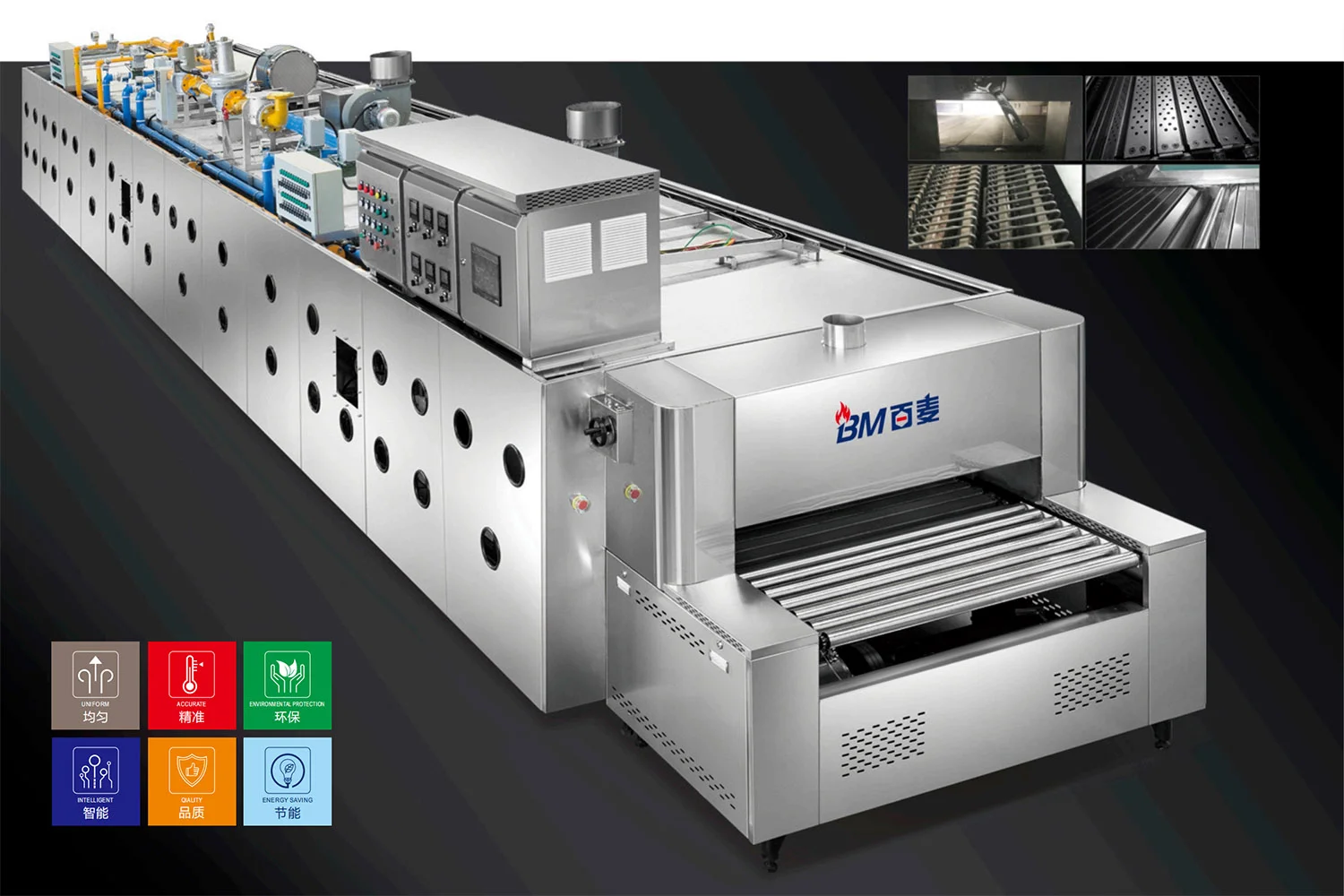- This topic is empty.
-
AuthorPosts
-
2025-06-26 at 6:54 pm #9310
In the landscape of modern industrial baking and thermal processing, tunnel ovens play an indispensable role in achieving high-throughput, consistent, and cost-efficient operations. Among the various heating technologies available, Direct Gas Fired (DGF) tunnel ovens have emerged as a premier choice for industrial-scale applications. These ovens are widely utilized across the baking, food processing, and ceramics industries due to their superior heat transfer efficiency, precise control, energy savings, and adaptability. In this blog post, Baimai, as a high performance industrial baking production equipment exporter, will share the performance advantages of direct gas fired industrial tunnel oven for sale.
Direct Gas Fired Industrial Tunnel Oven Performance Advantages
1. High Thermal Efficiency and Direct Heat Transfer
A core advantage of DGF tunnel ovens is their exceptional thermal efficiency. These ovens operate by burning natural gas or propane directly in the baking chamber, with combustion gases impinging directly on the product or the air circulating around it. Unlike indirect systems that require a heat exchanger, DGF systems minimize heat transfer losses, delivering efficiency ratings upwards of 85-90%.
This direct heat transfer mechanism allows the oven to reach and maintain set temperatures more rapidly, improving throughput while decreasing energy consumption. The intense radiant and convective heating also ensures even and consistent thermal distribution, reducing the likelihood of hot or cold spots in the product.
2. Fast Start-Up and Responsive Heat Control
In fast-paced industrial environments, time-to-temperature is a critical performance metric. Direct Gas Fired tunnel ovens excel in this regard by offering rapid start-up times compared to their electric or indirect-fired counterparts. The immediate presence of flame in the baking zone enables near-instantaneous heating, making it possible to transition quickly between production batches or respond to schedule changes without prolonged downtime.
Furthermore, these ovens are equipped with advanced burner control systems capable of finely modulating gas flow and flame intensity. This allows precise control over zone-specific temperatures, ensuring that different segments of the oven can be tailored to match the thermal profile requirements of various products.
3. Zonal Temperature Uniformity and Profile Customization
DGF tunnel ovens typically consist of multiple independent zones, each with its own burner, thermocouple sensors, and control unit. This zoned architecture enables precise customization of heat profiles, which is essential for products with specific baking, drying, or curing curves.
For example, in a baking application, the front zone can be set for high-temperature rapid rise (oven spring), the middle zone for product setting, and the final zone for crust development or moisture reduction. By adjusting each zone independently, manufacturers can achieve optimized product texture, color, and quality, minimizing rejects and ensuring uniformity across the batch.

4. Improved Product Quality and Repeatability
One of the most valued performance benefits of DGF tunnel ovens is their ability to deliver repeatable product quality at scale. Thanks to the uniform heat application and precise control, the ovens provide consistent results batch after batch. In food processing, this translates to uniform browning, even cooking, and optimized moisture content. In other industries, such as ceramics or nonwoven materials, it ensures precise sintering or curing profiles.
Modern DGF systems often include automated monitoring and feedback loops that adjust burner output in real-time based on in-process data, further ensuring reproducibility and reducing reliance on manual intervention.
5. Energy Cost Reduction and Sustainability
Energy consumption is a major operational expense for industrial facilities, and DGF tunnel ovens offer significant cost advantages. Natural gas is generally more affordable than electricity in most regions, and the high thermal efficiency of DGF systems ensures that more of the fuel’s energy is used in actual product heating rather than wasted as exhaust.
Many advanced DGF ovens also incorporate waste heat recovery systems, such as recuperators or heat exchangers that preheat combustion air or incoming product using flue gases. This leads to additional savings of 10–20% in energy costs, making DGF ovens a sustainable choice in the long run.
In regions with strict environmental regulations, the implementation of low-NOx burners and catalytic converters allows compliance with emissions standards while maintaining high performance.
6. Compact Design and Scalability
Direct Gas Fired tunnel ovens are typically more compact and space-efficient compared to indirect systems because they eliminate the need for bulky heat exchangers and secondary ducts. This reduced footprint is advantageous in factories where floor space is at a premium.
Moreover, these ovens are highly scalable, making them suitable for both medium-sized operations and large-scale, continuous production lines. Modular designs allow manufacturers to add additional zones or increase conveyor length as demand grows without overhauling the entire system.
7. Low Maintenance Requirements
The mechanical simplicity of DGF systems translates into lower maintenance costs and fewer points of failure. Since there are no intermediary heat exchangers or complex fluid circuits, there is a reduced risk of fouling, corrosion, or leakage that can plague indirect-fired systems.
Burners and control units are generally accessible and modular, allowing quick replacement or servicing. In many systems, predictive maintenance software is integrated to alert operators of declining burner performance, helping to prevent unexpected downtime.
8. High Flexibility Across Product Types
Another key advantage is the flexibility DGF ovens offer in terms of product compatibility. These systems can handle a wide range of materials and processes, including:
* Food Products: Bread, biscuits, pizzas, and ready-to-eat meals.
* Non-Food Applications: Textiles, nonwovens, rubber, adhesives, and composites.
* Industrial Materials: Ceramics, refractory materials, coatings, and insulation panels.
The versatility comes from the ability to modify air flow (convection), adjust burner position (radiant or impingement), and fine-tune thermal profiles to suit each product’s thermal behavior.
Conclusion
The Direct Gas Fired industrial tunnel oven represents a powerful, efficient, and flexible thermal processing solution for manufacturers across diverse sectors. With advantages in thermal efficiency, rapid heating, zonal control, product consistency, and energy cost savings, DGF ovens not only meet the demands of high-capacity production but also contribute to long-term operational excellence. Their ability to integrate with modern automation systems and sustainable energy practices makes them a forward-looking choice for manufacturers seeking both performance and environmental responsibility.
http://www.bmbaking.com
Baimai -
AuthorPosts
- You must be logged in to reply to this topic.
